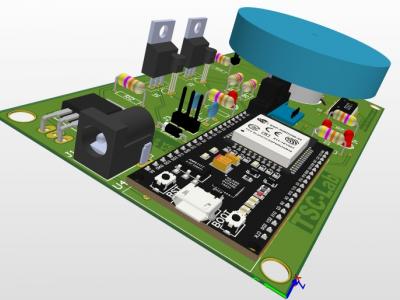Datasets
Standard Dataset
SSVEP-EEG data collection using Emotiv EPOC
- Citation Author(s):
- Submitted by:
- Victor Asanza
- Last updated:
- Tue, 08/22/2023 - 22:06
- DOI:
- 10.21227/0j42-qd38
- Data Format:
- Research Article Link:
- Links:
- License:
 35913 Views
35913 Views- Categories:
- Keywords:
Abstract
The data acquisition process begins with capturing EEG signals from 20 healthy skilled volunteers who gave their written consent before performing the experiments. Each volunteer was asked to repeat an experiment for 10 times at different frequencies; each experiment was trigger by a visual stimulus.
Each volunteer performed an experiment for each of the 10 visual stimuli frequencies (7, 9, 11 and 13). In each experiment the EEG signals generated in the 2 electrodes (LO, RO) of the occipital area was simultaneously recorded. It is important to note that the data acquisition equipment has a sampling rate of 128 samples per second, allowing to acquire 2500 samples, considering that each task has a duration of 19.5 seconds.
⭐ When using this resource, please cite the original publication:
References:
- J. Fuentes-Gonzalez, A. Infante-Alarcón, V. Asanza and F. R. Loayza, "A 3D-Printed EEG based Prosthetic Arm," 2020 IEEE International Conference on E-health Networking, Application & Services (HEALTHCOM), Shenzhen, China, 2021, pp. 1-5, doi: 10.1109/HEALTHCOM49281.2021.9399035.
- V. Asanza, A. Constantine, S. Valarezo and E. Peláez, "Implementation of a Classification System of EEG Signals Based on FPGA," 2020 Seventh International Conference on eDemocracy & eGovernment (ICEDEG), Buenos Aires, Argentina, 2020, pp. 87-92, doi: 10.1109/ICEDEG48599.2020.9096752.
- C. Cedeño Z., J. Cordova-Garcia, V. Asanza A., R. Ponguillo and L. Muñoz M., "k-NN-Based EMG Recognition for Gestures Communication with Limited Hardware Resources," 2019 IEEE SmartWorld, Ubiquitous Intelligence & Computing, Advanced & Trusted Computing, Scalable Computing & Communications, Cloud & Big Data Computing, Internet of People and Smart City Innovation (SmartWorld/SCALCOM/UIC/ATC/CBDCom/IOP/SCI), Leicester, United Kingdom, 2019, pp. 812-817.
- Asanza, V., Peláez, E., Loayza, F., Mesa, I., Díaz, J., & Valarezo, E. (2018, October). EMG Signal Processing with Clustering Algorithms for motor gesture Tasks. In 2018 IEEE Third Ecuador Technical Chapters Meeting (ETCM) (pp. 1-6). IEEE.
- Asanza, V., Pelaez, E., & Loayza, F. (2017, October). Supervised pattern recognition techniques for detecting motor intention of lower limbs in subjects with cerebral palsy. In Ecuador Technical Chapters Meeting (ETCM), 2017 IEEE (pp. 1-5). IEEE.
- Asanza, V., Pelaez, E., & Loayza, F. (2017, October). EEG signal clustering for motor and imaginary motor tasks on hands and feet. In Ecuador Technical Chapters Meeting (ETCM), 2017 IEEE (pp. 1-5). IEEE.
- Asanza, V., Ochoa, K., Sacarelo, C., Salazar, C., Loayza, F., Vaca, C., & Peláez, E. (2016, October). Clustering of EEG occipital signals using k-means. In Ecuador Technical Chapters Meeting (ETCM), IEEE (pp. 1-5). IEEE.
- 1_EmotivData.csv
- Raw data generated by the Emotiv EPOC device that include "Timestamp", 14 electrodes, battery level (0 - 4) and "MarkerValueInt" with values 1 -5 where they indicate the moment in which the test subject receives 7Hz optical stimuli , 9Hz, 11Hz, 13Hz and resting task.
- 2_Raw_Data.csv
- Raw data, with 2 electrodes (Occipital 1 and 2) from the Emotv EPOC device and labeled data: 1 for 7Hz of stimulus, 2 for 9Hz of stimulus, 3 for 11Hz of stimulus, 4 for 13Hz of stimulus and 5 for resting task.
- 3_Filtered_Data.csv
- Filtered data and separated into folders: 7Hz, 9Hz, 11Hz, 13Hz and Resting Task (The band-pass filter matlab code script used is also included).
Dataset Files
- 1_EmotivData.zip (133.98 MB)
- 2_Raw_Data.zip (10.59 MB)
- 3_Filtered_Data.zip (16.10 MB)
- Bandpass filter matlab code used Band_Pass_Filter_5_30Hz.m (801 bytes)









Comments
i need to SSVEP dataset for test my project about control wheelchair with BCI
Dear Mr. Achraf Addali,
The dataset I used in my article is as follows:
https://ieee-dataport.org/documents/ssvep-eeg-data-collection-using-emot...
https://ieee-dataport.s3.amazonaws.com/data/54588/2_Raw_Data.zip?respons...
The article I used those dataset is as follows:
https://www.sciencedirect.com/science/article/pii/S240589632101692X?via%...
The codes used are here:
https://github.com/vasanza/Matlab_Code
I also share with you the link to my personal blog where you can find information about my recent work:
https://vasanza.blogspot.com/p/about-me.html
Best regards
111
Dear Mr. He Mengjia,
The dataset I used in my article is as follows:
https://ieee-dataport.org/documents/ssvep-eeg-data-collection-using-emot...
https://ieee-dataport.s3.amazonaws.com/data/54588/2_Raw_Data.zip?respons...
The article I used those dataset is as follows:
https://www.sciencedirect.com/science/article/pii/S240589632101692X?via%...
The codes used are here:
https://github.com/vasanza/Matlab_Code
I also share with you the link to my personal blog where you can find information about my recent work:
https://vasanza.blogspot.com/p/about-me.html
Best regards
Translated with www.DeepL.com/Translator (free version)